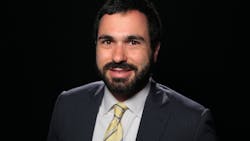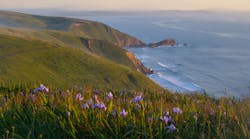Alma Mater: UCLA, BA and University of Pennsylvania, MCP
Fast fact about yourself: When moving back to California from Pennsylvania, a friend and I took the train cross-country.
What’s your best experience on transit and what made it memorable?: My favorite experience on transit is riding on high-speed rail when it’s going full speed parallel to a freeway and the cars look like they are standing still. That’s when you really appreciate what high-speed really means.
Boris Lipkin has devoted nearly his entire career to making high-speed rail in the United States a reality. He began work on California’s transformative high-speed rail project in 2011 as a consultant, developing ridership forecasts, economic analysis, funding plans and strategies to access and secure funding for the project. At age 27, he was appointed by former California Gov. Jerry Brown as the California High-Speed Rail Authority’s (CHSRA) first deputy director of strategic planning. He worked to solve some of the biggest challenges, including developing and executing a multistep plan to access $3 billion in state bond funds.
Three years later at age 30, Lipkin was appointed by former Gov. Brown to lead the development of high-speed rail in northern California as the northern California regional director and was reappointed by current California Gov. Gavin Newsom in 2020. During his tenure, Lipkin led the successful certification of environmental clearance for almost 150 miles of high-speed rail in northern California from San Francisco to Merced.
At the time of his initial appointment in 2018, the authority had been working on environmental clearance for nearly eight years; relationships with local stakeholders were strained as this process dragged on. Within a year of Lipkin in the lead, his diplomacy fostered trust and built the foundation for strong partnerships throughout the region.
Lipkin is well-known for his pragmatism in transforming the region’s transportation network into a world-class system. He is well respected among peer agency executives, mayors and business leaders. He has worked diligently with regional partners to implement policies that advance high-speed rail initiatives and support regional readiness for when high-speed rail is operational, namely the Metropolitan Transportation Commission’s Plan Bay Area 2050. Another example of his regional leadership is his role as a Transbay Joint Powers Authority (TJPA) Board Member. The TJPA built and operates the newly opened four-block long Salesforce Transit Center (STC) in downtown San Francisco, which will be the northern terminal for the statewide high-speed rail system and is currently advancing toward construction of the tunnel that will connect the existing Caltrain corridor and future high-speed rail service to STC.
In his executive leadership role within the state of California, Lipkin leads the Northern California Regional Office team made up of engineers, environmental and planning professionals and outreach and communications experts. With his guidance, the team is encouraged to work with local jurisdictions to develop creative design solutions and mitigations, including a multi-year environmental justice engagement process that resulted in the CHSRA’s commitment of more than $60 million in community improvements in eight underserved communities along the alignment. This work has been recognized by the American Planning Association’s California – Northern Section, with the 2023 Excellence Award for Advancing Diversity and Social Change in Honor of Paul Davidoff.
Lipkin is a regular guest lecturer at Stanford University, Mineta Transportation Institute and San Jose State University, and at other universities across the country. He was also a founding board member of the San Francisco Bay Chapter of Young Professionals in Transportation and served on the international board of directors, as well.
He holds bachelor’s degrees in business economics and geography from UCLA, where he graduated cum laude and a master’s degree in city planning from the University of Pennsylvania.
Is there a specific experience that led you to where you are today?
I lived in two different worlds before I truly appreciated the transformative powers of transportation. I grew up in the suburbs on the San Francisco Peninsula and spent formative childhood years in Moscow, Russia. In Moscow, we got around primarily on public transit and on foot. In the suburbs, however, getting a driver’s license and a car were your keys to freedom. While taking urban studies courses at UCLA, I gravitated towards cities and transportation.
I realized how much transportation systems drive how people experience the world, how cities are built and impact climate, safety and more. Experiencing the frustration of getting around in Los Angeles by any mode (and it’s gotten better since then) really cemented to me the importance of creating user-friendly transit systems and networks that can get you from place to place without a car or getting stuck in traffic. This experience led me to the career path of improving the transportation options we have. In the case of high-speed rail, bringing something wholly new to the equation in California.
What do you enjoy most about your job?
Getting things done. On a megaproject of building a 500-mile high-speed rail network across California, it’s important to always make progress toward that goal. These large projects don’t happen overnight, but by getting things done and maintaining momentum, you can see tangible results. The sense of accomplishment when big things happen is the best feeling, and when you can share it with a team that worked hard together to get to that point, it’s even sweeter.
What’s the most challenging part of your job?
The idea for high-speed rail in California is an easy one to like: A 220 mph train powered by renewable energy that can get you from San Francisco to Los Angeles in under three hours and even connect communities in between. The voters of California bought into that idea in 2008 when they approved the system. The idea is compelling. Making it a reality is challenging and exciting. The hardest parts of working on high-speed rail is we don’t have a system like this in the U.S. that people have experienced for themselves. The project is so ambitious and unmatched in scale that people’s excitement often outstrips how fast it can be built.
Seeing is believing. Until we can show someone what it’s like to ride on a high-speed rail system, it can still feel far-fetched to those who doubt that this is something we can do. Combined with that is the uncertainty of funding. We work hard to engage our communities with full transparency to explain what the system is and isn’t, what our plans are, how they will be implemented and what the impacts might be.
Accomplishment you’re most proud of and why?
I’m most proud of leading and fast-tracking the largest statewide environmental clearance effort undertaken since the California Environmental Quality Act (CEQA) was enacted in the 1970s. With my incredible team, two project sections totaling nearly 150 miles gained certification within a few months of each other with strong support from stakeholders throughout the region.
In 2022, the CHSRA Board of Directors unanimously approved the environmental documents, moving the project forward and reaching 422 miles of environmental clearance for the 500-mile high-speed rail system.
When I came into this role in 2018, the authority spent almost a decade studying different alignment options but had yet to select a preferred alignment or issue draft environmental documents for public review. After I joined, we had a preferred alternative within a year, draft environmental documents in two years and crossed the finish line in four years amid a pandemic.
This accomplishment was made possible by building a strong team of state staff and consultants with a variety of expertise from planning, engineering, rail operations, environmental analysis, outreach, communications and more. They worked cohesively to get things done. Having a team that pulls in the same direction while each having specific roles is essential to pulling off a feat like this. We had the best team I could ask for.
Best advice/tip/best practice to share from your area of expertise?
The best advice that I can share, especially for someone starting out in their career, is that if you want to find ways to get more responsibility, always be willing to say yes to a new assignment or task and to do it well. Demonstrating that you are reliable, diligent, and proactive will always go a long way to being asked to take on larger tasks and leadership roles.

Brandon Lewis | Associate Editor
Brandon Lewis is a recent graduate of Kent State University with a bachelor’s degree in journalism. Lewis is a former freelance editorial assistant at Vehicle Service Pros in Endeavor Business Media’s Vehicle Repair Group. Lewis brings his knowledge of web managing, copyediting and SEO practices to Mass Transit Magazine as an associate editor. He is also a co-host of the Infrastructure Technology Podcast.






